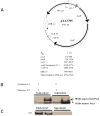Evaluation of the humoral immune response in mice orally vaccinated with live recombinant attenuated Salmonella enterica delivering a secreted form of Yersinia pestis PsaA
- PMID: 20600475
- PMCID: PMC2921469
- DOI: 10.1016/j.vaccine.2010.06.070
Evaluation of the humoral immune response in mice orally vaccinated with live recombinant attenuated Salmonella enterica delivering a secreted form of Yersinia pestis PsaA
Abstract
Yersinia pestis PsaA is an adhesin that is synthesized inside macrophages. Here, we evaluated the immune profile of codon-optimized Y. pestis PsaA synthesized in a live recombinant attenuated Salmonella vaccine (RASV) strain chi9558. Oral immunization of BALB/c mice with chi9558(pYA3705) delivering a secreted form of PsaA, elicited a systemic PsaA-specific immunoglobulin G (IgG) response but offered limited protection against lethal challenge with the intranasally introduced Y. pestis CO92 strain. Our results suggest that appropriate fine-tuning of Y. pestis PsaA delivery by RASV could improve its protective role in curtailing plague colonization and infection.
Figures




Similar articles
-
Multiple antigens of Yersinia pestis delivered by live recombinant attenuated Salmonella vaccine strains elicit protective immunity against plague.Vaccine. 2016 May 5;34(21):2410-2416. doi: 10.1016/j.vaccine.2016.03.094. Epub 2016 Apr 6. Vaccine. 2016. PMID: 27060051 Free PMC article.
-
Humoral and cellular immune correlates of protection against bubonic plague by a live Yersinia pseudotuberculosis vaccine.Vaccine. 2019 Jan 3;37(1):123-129. doi: 10.1016/j.vaccine.2018.11.022. Epub 2018 Nov 19. Vaccine. 2019. PMID: 30467064
-
Evaluation of Psn, HmuR and a modified LcrV protein delivered to mice by live attenuated Salmonella as a vaccine against bubonic and pneumonic Yersinia pestis challenge.Vaccine. 2010 Dec 16;29(2):274-82. doi: 10.1016/j.vaccine.2010.10.033. Epub 2010 Oct 24. Vaccine. 2010. PMID: 20979987 Free PMC article.
-
Developing live vaccines against plague.J Infect Dev Ctries. 2011 Sep 14;5(9):614-27. doi: 10.3855/jidc.2030. J Infect Dev Ctries. 2011. PMID: 21918302 Free PMC article. Review.
-
Protecting against plague: towards a next-generation vaccine.Clin Exp Immunol. 2013 Apr;172(1):1-8. doi: 10.1111/cei.12044. Clin Exp Immunol. 2013. PMID: 23480179 Free PMC article. Review.
Cited by
-
Live attenuated Salmonella vaccines against Mycobacterium tuberculosis with antigen delivery via the type III secretion system.Infect Immun. 2012 Feb;80(2):798-814. doi: 10.1128/IAI.05525-11. Epub 2011 Dec 5. Infect Immun. 2012. PMID: 22144486 Free PMC article.
-
The efficacy, biodistribution and safety of an inhibin DNA vaccine delivered by attenuated Salmonella choleraesuis.Microb Biotechnol. 2018 Jan;11(1):248-256. doi: 10.1111/1751-7915.13029. Epub 2017 Dec 4. Microb Biotechnol. 2018. PMID: 29205848 Free PMC article.
-
Multiple antigens of Yersinia pestis delivered by live recombinant attenuated Salmonella vaccine strains elicit protective immunity against plague.Vaccine. 2016 May 5;34(21):2410-2416. doi: 10.1016/j.vaccine.2016.03.094. Epub 2016 Apr 6. Vaccine. 2016. PMID: 27060051 Free PMC article.
-
Intranasal delivery of a protein subunit vaccine using a Tobacco Mosaic Virus platform protects against pneumonic plague.Vaccine. 2016 Nov 11;34(47):5768-5776. doi: 10.1016/j.vaccine.2016.09.063. Epub 2016 Oct 13. Vaccine. 2016. PMID: 27745954 Free PMC article.
-
Construction and Evaluation of Recombinant Attenuated Edwardsiella piscicida Vaccine (RAEV) Vector System Encoding Ichthyophthirius multifiliis (Ich) Antigen IAG52B.Front Immunol. 2022 Jan 25;12:802760. doi: 10.3389/fimmu.2021.802760. eCollection 2021. Front Immunol. 2022. PMID: 35145512 Free PMC article.
References
-
- Hinnebusch BJ. The evolution of flea-borne transmission in Yersinia pestis. Curr Issues Mol Biol. 2005;7(2):197–212. - PubMed
-
- Inglesby TV, Dennis DT, Henderson DA, Bartlett JG, Ascher MS, Eitzen E, et al. Plague as a biological weapon: medical and public health management. JAMA. 2000;283(17):2281–90. - PubMed
-
- Russell P, Eley SM, Hibbs SE, Manchee RJ, Stagg AJ, Titball RW. A comparison of Plague vaccine, USP and EV76 vaccine induced protection against Yersinia pestis in a murine model. Vaccine. 1995;13(16):1551–6. - PubMed
Publication types
MeSH terms
Substances
Grants and funding
LinkOut - more resources
Full Text Sources
Medical

